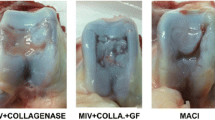Abstract
Autologous chondrocyte implantation (ACI) for the treatment of articular cartilage defects has been described by other workers, however, relatively few details of the in vitro growth of the cells have been published. Here we describe the release of cells from adult human articular cartilage and their growth characteristics in vitro.
Cultures were successfully established from 29 of 30 biopsies taken from patients aged 20–72 year. No significant relationship was found between donor age and initial cell yield following cartilage digest, however, the time to primary confluence increased in direct proportion to age. Thereafter the kinetics of cell proliferation was independent of donor age.
The proportion of apoptotic or necrotic cells in the cartilage digest was low and increased with time in culture only in those cells which remained non-adherent. Conversely, entry into cell cycle was restricted to those cells which had become adherent.
These results illustrate that previously reported techniques for isolating and culturing chondrocytes are reproducible, that adherent chondrocytes have considerable proliferative potential, and that concern about cell growth and viability need not, in itself, limit the clinical application of ACI to younger patients.
Similar content being viewed by others
References
Ashton BA, Ashton IK, Marshall MJ and Butler RC (1993) Localisation of vitronectin receptor immunoreactivity and tartrate resistant acid phosphatase activity in synovium from patients with inflammatory or degenerative arthritis. Ann Rheum Dis 52: 133-7
Binette F, McQuaid DP, Haudenschild DR, Yaeger PC, McPherson JM and Tubo R (1998) Expression of a stable articular cartilage phenotype without evidence of hypertrophy by adult human articular chondrocytes in vitro. J Orthop Res 16: 207-16
Brittberg M, Lindahl A, Nilsson A, Ohlsson C, Isaksson O and Peterson L (1994) Treatment of deep cartilage defects in the knee with autologous chondrocyte transplantation. N Engl J Med 331: 889-95
Gerdes J, Li L, Schlueter C, Duchrow M, Wohlenberg C, Gerlach C, Stahmer I, Kloth S, Brandt E and Flad HD (1991) Immunobiochemical and molecular biologic characterization of the cell proliferation-associated nuclear antigen that is defined by monoclonal antibody Ki-67. Am J Pathol 138: 867-73
Hashimoto S, Ochs RL, Komiya S and Lotz M (1998) Linkage of chondrocyte apoptosis and cartilage degradation in human osteoarthritis. Arthritis Rheum 41: 1632-8
Ilic D, Almeida EAC, Schlaepfer DD, Dazin P, Aizawa S and Damsky CH (1998) Extracellular martix survival signals transduced by focal adhesion kinase suppress p53-mediated apoptosis. J Cell Biol 143: 547-60
Liu H, Lee YW and Dean MF (1998) Re-expression of differentiated proteoglycan phenotype by dedifferentiated human chondrocytes during culture in alginate beads. Biochim Biophys Acta 1425: 505-15
Meachim G and Collins DH (1962) Cell counts of normal and osteoarthritic articular cartilage in relation to the uptake of sulphate (35SO4) in vitro. Ann Rhem Dis 21: 45-53
Minas T and Peterson L (1999) Advanced techniques in autologous chondrocyte transplantation. Clin Sports Med 18: 13-44, v-vi
Negoescu A, Lorimer P, Labat-Moleur F, Azoti L, Robert C, Guillermet C and Brambilla C (1997) TUNEL: Improvement and evaluation of the method for in situ apoptotic cell identification. Biochemica 2: 12-16
Quintero M, Mitrovic DR, Stankovic A, de Seze S, Miravet L and Ryckewaert A (1984) Cellular aspects of the aging of articular cartilage. I. Condylar cartilage with a normal surface sampled from normal knees. Rev Rhum Mal Osteoartic 51: 375-9
Richardson JB, Caterson B, Evans EH, Ashton BA and Roberts S (1999) Repair of human articular cartilage after implantation of autologous chondrocytes. J Bone Jt Surg (Br) 81(B): 1064-8
Schluter C, Duchrow M, Wohlenberg C, Becker MH, Key G, Flad HD and Gerdes J (1993) The cell proliferation-associated antigen of antibody Ki-67: a very large, ubiquitous nuclear protein with numerous repeated elements, representing a new kind of cell cycle-maintaining proteins. J Cell Biol 123: 513-22
Stockwell RA (1967) The cell density of human articular and costal cartilage. J Anat 101: 753-63
Svoboda KK (1998) Chondrocyte-matrix attachment complexes mediate survival and differentiation. Microsc Res Tech 43: 111-122
Author information
Authors and Affiliations
Corresponding author
Rights and permissions
About this article
Cite this article
Harrison, P., Ashton, I., Johnson, W. et al. The in Vitro Growth of Human Chondrocytes. Cell Tissue Banking 1, 255–260 (2000). https://doi.org/10.1023/A:1010131729208
Issue Date:
DOI: https://doi.org/10.1023/A:1010131729208




